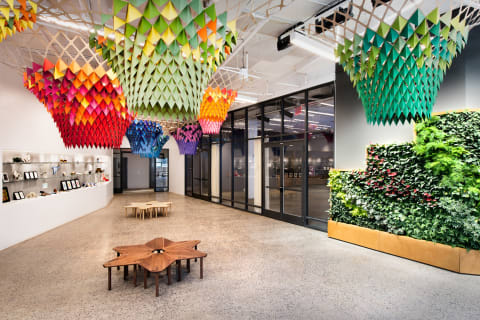Advertisement

For thousands of years, humans created buildings that responded to the climate, culture, and place. But over the last century, we have started making cookie-cutter spaces around the world, cutting ourselves off from the outside. Biophilic design aims to reverse this trend. Largely kicked off by the 2008 book Biophilic Design: The Theory, Science and Practice of Bringing Buildings to Life, the movement now seeks to reconnect people and nature in creative new ways.
Haven’t you always dreamed of working in a treehouse, at the beach, or in a field of rustling grasses? At its core, biophilic design aims to make this a reality.
The science of biophilic design.
We spend 90 percent1 of our time indoors, removed from the world around us. Most contemporary Western architecture sees our buildings as tools to assert domination over nature and highlight our separation from it.
But with an increased focus on health and wellness, we're starting to realize that the spaces that we spend so much time in should be using more principles from nature, not fewer. When buildings capture the movement of the sun through the sky using windows, patterns, and architectural details, these dynamic shadows and pools of light connect us to the time of day, the season, and our inner biorhythms. There is a lasting and healing power in these spaces, and they can serve as touchstones whenever we need a respite from our busy and sometimes stressful lives.
Studies show that when we are connected to daylight in this way, we are actually less sick and more focused and productive. Back in 1984, Roger Ulrich discovered that2 hospital recovery rates were reduced when patients simply looked at nature through a window, and several other studies have since discovered more links between access to nature and health. Test scores in schools were shown to be higher when students had access to daylight, for example.
How to bring it into your own life.

I started working in architecture over 20 years ago, on a mission to dissolve the walls that existed between the inside and outside. Needless to say, biophilic design has always made inherent sense to me, and I'm so excited to see it begin to emerge as a design trend. Now, I'm working to help massive companies including Google and Etsy incorporate it into their offices to create healthier environments for their employees. They've created a diverse range of dynamic and varied spatial conditions for employees to work away from their desks, mimicking the spatial variability found in nature and allowing people to be more focused and productive.
Spaces inspired by the patterns, rhythms, and features of nature can do wonders to promote well-being. Here are a few ways to apply biophilic design principles in your own home:
1. Bring in curved elements whenever possible.
Even though humans have a deep, inherent affinity for curved shapes and their sense of order, complexity, and beauty, most of our building materials are dominated by straight lines and right angles. These days, it is difficult and expensive to build the curved shapes and forms that we find in waves, flowers, and shells. However, patterns from nature can be soothing even when used decoratively as motifs.
2. Create multisensory experiences.
Plentiful daylight and windows that open to allow access to fresh air serve to connect us with the outside. I have often found that people turn on heating and cooling systems even when the temperature outside is only a few degrees different from what they're looking for. Open the window whenever you can!
3. Craft outdoor rooms.
Even a small backyard, patio, or deck can become a fully functional outdoor space. No matter where you live, you can probably use yours as a work space or living room for at least six months out of the year. Spending more time outside lounging or working helps us feel sheltered in nature, blurring the separation between inside and outside.
4. Remember the variety in nature.
Nature is not monotone—colors, shapes, and spaces always shift as shadows move and leaves sprout and fall. Crafting a space that has space for standing and sitting, is quiet in some areas and loud in others, and transitions between vivid and neutral colors can replicate the experience of being outside.
Here's some more science on what makes nature so restorative, and an epic experiment that proves how healing it can be.
Watch Next
Enjoy some of our favorite clips from classes
Enjoy some of our favorite clips from classes
What Is Meditation?
Mindfulness/Spirituality | Light Watkins
Box Breathing
Mindfulness/Spirituality | Gwen Dittmar
What Breathwork Can Address
Mindfulness/Spirituality | Gwen Dittmar
The 8 Limbs of Yoga - What is Asana?
Yoga | Caley Alyssa
Two Standing Postures to Open Up Tight Hips
Yoga | Caley Alyssa
How Plants Can Optimize Athletic Performance
Nutrition | Rich Roll
What to Eat Before a Workout
Nutrition | Rich Roll
How Ayurveda Helps Us Navigate Modern Life
Nutrition | Sahara Rose
Messages About Love & Relationships
Love & Relationships | Esther Perel
Love Languages
Love & Relationships | Esther Perel












